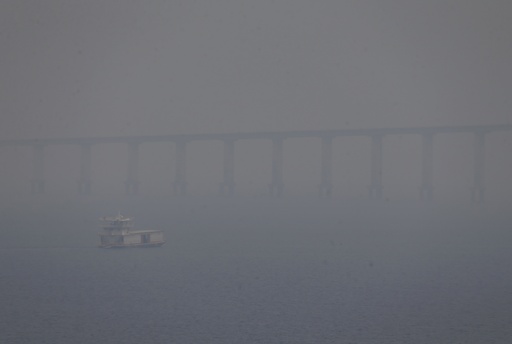BRASILIA, Brazil – Recent satellite evaluations indicate that devastating wildfires have ravaged an area of Brazil comparable to Switzerland, leaving destruction that may take decades, if not longer, to restore fully. The extent of the loss and degradation was underscored as smoke that had engulfed the nation began to clear, aided by rainfall that seems to be concluding what has been recorded as Brazil’s most severe drought.
Ane Alencar, who serves as the science director at the Amazon Environmental Research Institute, expressed grave concern regarding the findings, describing the situation as “exceptionally alarming,” citing a dramatic increase in fire activity.
According to data, the area burned from January through mid-October 2024 marks an astonishing 846% increase compared to the same timeframe in 2023. This surge significantly overshadows the forest fires recorded in 2019, during the presidency of Jair Bolsonaro, when widespread destruction of the Amazon drew international attention.
The estimates stem from the National Institute for Space Research, responsible for monitoring Brazil’s official deforestation rates. This concerning trend arises just a year ahead of the U.N. climate conference, COP30, set to take place in Belém, raising alarms among experts and governmental authorities who suspect that some individuals are exploiting climate change for illicit gains.
Traditionally, deforestation in the Amazon begins with the use of chainsaws, leaving downed trees until they dry sufficiently for burning. However, it appears that with the ongoing drought, illegal actors are opting to bypass the labor-intensive process of felling trees altogether. Instead, a mere lighter and gasoline are now sufficient to ignite a blaze.
Alencar noted the crucial role of drought in facilitating the aggressive spread of fires, while emphasizing that fire itself has also become a tool for exploitation. André Lima, who is the secretary of deforestation control at the Ministry of the Environment and Climate Change, remarked on the forest’s alarming lack of resilience against prolonged drought. He stated that the impact of a controlled number of individuals can wreak havoc, with just a few starting numerous large fires.
The situation has been exacerbated by climate change induced by human activity as well as the El Niño phenomenon, pushing the Amazon basin, the world’s largest, into two consecutive years of serious drought. Rivers have reached precariously low levels, contributing to the deaths of fish and endangered species such as river dolphins, while many communities nestled along the rivers are stranded without means of transport.
In September, the number of wildfires escalated significantly, resulting in twice the area burned in previous months. As 2024 nears its end, this year is already marked as having the largest area affected by fire since the advent of current monitoring methodologies a decade ago.
This alarming surge in forest destruction emerges while global delegates gather in Cali, Colombia, for COP16, aiming to discuss conservation efforts aimed at preserving biodiversity. Lima mentioned that further examination is needed to substantiate claims that criminal enterprises are capitalizing on climate changes; however, preliminary evidence suggests this is a growing concern. He noted the Jamanxim National Forest as a particularly hard-hit area, where landgrabbers have illegally engaged in cattle ranching, often hoping for eventual legalization of their activities.
This forest, located close to Novo Progresso, which has seen significant deforestation, previously voted heavily in favor of Bolsonaro—who emphasized economic expansion over ecological conservation—in the 2022 election. Statistics reveal that Jamanxim has endured fires affecting 1,900 square kilometers (733 square miles) in 2024 alone, mainly in September, representing a staggering 700% increase compared to the previous year.
In response to the rampant destruction, the Brazilian government is contemplating a mandate for the reforestation of all areas that have experienced fire, aimed at discouraging land grabbers from converting public forests into private farmland. Lima advocates for localized governmental actions, given that most fires originate on privately-owned rural lands, necessitating collective policy adjustments to combat climate change effectively.
The surge of wildfires in the Amazon is part of a larger global trend that exacerbates climate change. A recent study indicated that carbon emissions from forest fires have surged by 60% between 2001 and 2023, highlighting that forests, rich with carbon storage, are increasingly at risk of fires.
In contrast to wildfire patterns in North America, where flames often reach the treetops, fires in the Amazon predominantly spread through ground-level leaves, leading to less immediate harm. The deforestation monitoring agency, INPE, categorizes these areas as burn scars rather than outright deforestation. Consequently, despite the increase in flames, the deforestation rate appears to have slowed under President Luiz Inácio Lula da Silva’s administration and may conclude 2024 with a projected 60% reduction compared to the Bolsonaro era. This situation illustrates that deforestation is merely one aspect of ecological harm—insufficient to capture the full scope of forest degradation occurring in a given year.
Claudio Almeida, a senior officer at INPE, stated that in regions heavily afflicted by fire, the forest may face significant collapse. Even areas that have not been as severely impacted are left fragile and degraded. Another season of intense drought and fires could spell disaster for these ecosystems.
